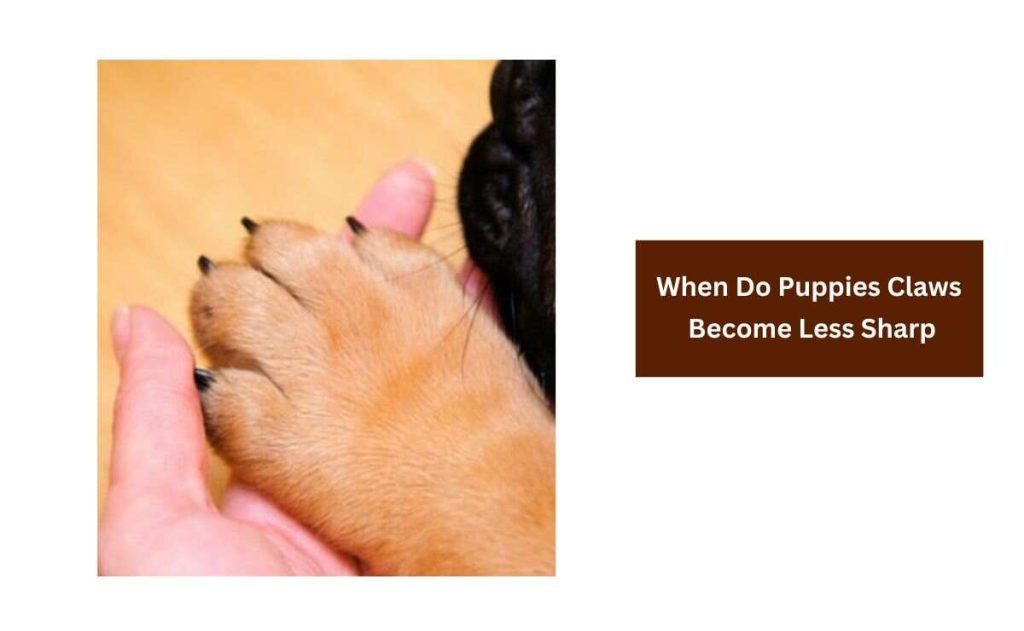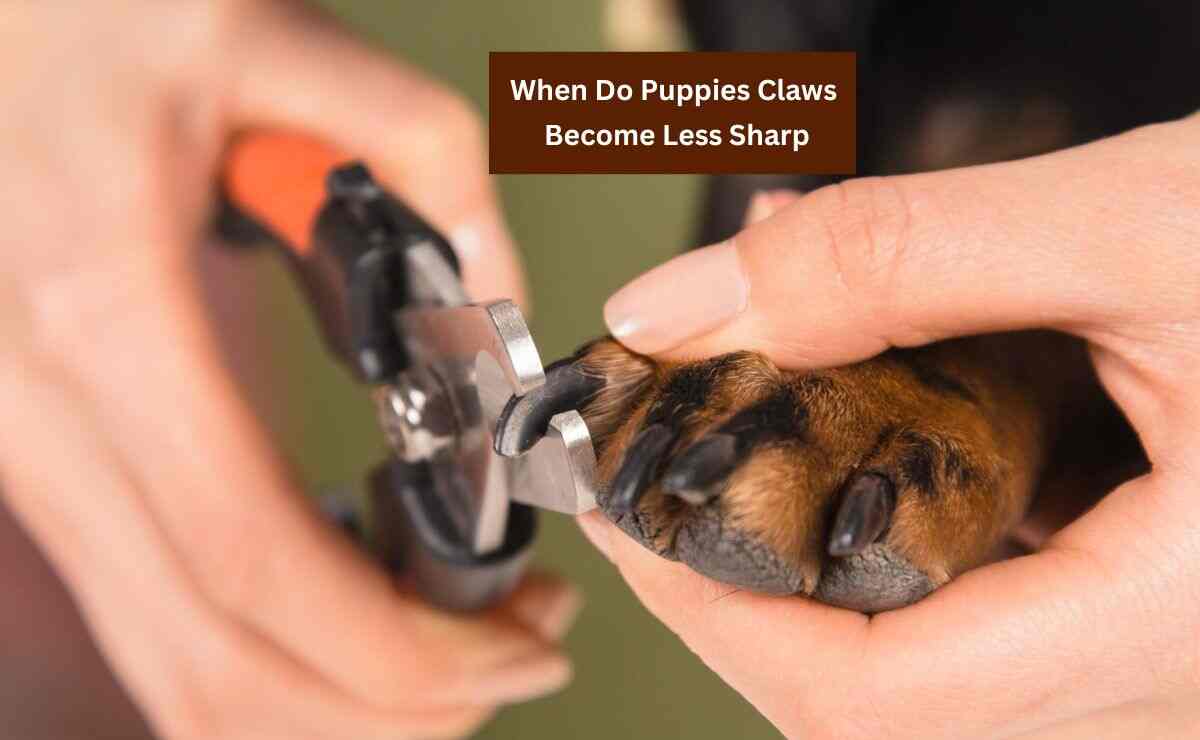Whether puppies are born or you bring new puppies into your home, there is no bond of happiness. Though new-born puppies have tiny, plain claws. But soon their claws get sharper, pointer, and powerful as they grow up. It becomes a headache when they start scratching furniture, sofas, or even your skin.
So you should know when puppy claws become less sharp. Sharp nails on claws are problematic for the owners. The natural wear and tear process starts after a few months. When your puppies get active, walk and run on hard surfaces, their nails naturally wear down.
When Do Puppies Claws Become Less Sharp?

As puppies grow and develop, their claws go through a natural process of becoming less sharp. When puppies are born, their claws are typically sharp and pointy. They use their claws to navigate and grasp onto surfaces as they explore their new world.
Around the age of three to four weeks, a puppy’s claws will start to become slightly blunter. Their constant scratching and interaction with their littermates and environment make this happen. As they continue to grow, their claws will gradually become less sharp.
When a puppy is around eight weeks old, their claws should be significantly less sharp compared to when they were born. Due to normal daily activities such as walking, running, and playing, their claws are worn down.
Though a puppy’s claws will naturally become less sharp over time, you have to regularly trim their claws to prevent accidents or injuries. Trimming a puppy’s claws also helps to prevent them from scratching themselves or others unintentionally.
Why is My Puppy’s Nails So Sharp?
Puppies’ nails are intricately connected to their bone structure, forming part of their wrist. These nails are basically extensions of their bones, covered by sturdy keratin. This structure of their claws allows them to dig, sprint with lightning speed, maintain better balance, and some can even showcase impressive tree-climbing skills.
Much like human fingernails, a dog’s nails act as protective shields for their toes and paws. In the wild, dogs relied on their claws and teeth for self-defense against potential threats. However, in the cozy domestic environment, they don’t need such fighting for protection. So, in this state, sharp nails can sometimes pose more harm than good.
The length and thickness of your puppy’s claws tell their sharpness. Generally, longer and thicker claws tend to be sharper and pose a potential threat. On the other side, wear and tear can reduce the sharpness.
To ensure a harmonious coexistence, it’s essential to teach your puppy proper nail etiquette. Introduce them to scratching posts and other suitable surfaces to redirect their natural instincts without sacrificing the joy of play. Remember, a little training goes a long way in keeping those sharp claws from causing unintended harm.
When Should You First Clip Puppies’ Nails?
Ideally, you should start the nail-clipping process during the first week of welcoming your puppy into the new home. This early introduction helps them conform to the procedure and minimizes resistance or fear in the future.
After that, you should clip your puppy’s nails every week. Regular sessions familiarize your puppy with the process. Consistency is the key to building a positive context and your puppy won’t build up a lifelong fear of nail trimming.
Also, you should maintain proper accuracy while clipping your pup’s nails. A misstep, like cutting too much and hitting the quick (the sensitive part of the nail), can lead to bleeding and create a lasting fear in your pup.
Some dogs have dark-colored nails so you may have confusion finding the end of the nails. So you should trim the sharp edges without clipping too deep. If your puppy’s nail-clicking sounds echo as they walk, it’s a clear indicator that a trim is due.
While trimming is vital, cutting too short can have consequences like bleeding, infections, and potential behavioral issues. So you have to maintain the proper length so that there is no form of long-term aversions or aggression.
How To Trim Your Puppies Nails?
Trimming your puppy’s nails is an important aspect of their grooming routine. It not only helps keep their nails at a proper length but also prevents them from getting snagged or broken, which can be painful.
Some puppies may find nail trimming to be a stressful experience, but with the right technique and approach, you can make it a positive and stress-free experience for your puppy.
Here is a step-by-step guide:
1. Gather the necessary Tools: Before you begin, gather all the supplies you will need. You need a pair of sharp and clean dog nail clippers, styptic powder (to stop bleeding in case you accidentally cut too far), and treats or rewards for your pup.
2. Get your puppy comfortable: Find a quiet and calm area where you can comfortably trim your puppy’s nails. It is important to create a positive environment with this activity. You can also keep their favorite treats or toys nearby.
3. Get your puppy used to handling their paws: Before trimming their nails, get your puppy used to having their paws handled. Gently touch and massage their paws, and reward them with treats and praise. This will help your puppy feel more comfortable during the nail-trimming process.
4. Identify the proper length: Look at your puppy’s nails and identify the part called the quick – the sensitive living tissue inside the nail. You should aim to trim just the tip of the nail.
5. Begin the trimming process: Hold your puppy’s paw firmly but gently. Carefully insert the nail clippers around the tip of the nail and make a smooth and quick cut. Avoid cutting too close to the quick. If your puppy has clear nails, it will be easier to see where the quick begins. If their nails are dark, err on the side of caution and trim small amounts at a time.
6. Use treats and positive reinforcement: Throughout the process, reward your puppy with treats and praise. This will help create a positive experience and make future nail trimmings easier. If your puppy becomes anxious or stressed, take a break. Provide them with reassurance and rewards, and try again later or the next day.
8. File the nails: If your puppy’s nails are still sharp after trimming, you can use a nail file or emery board to smooth out any rough edges. Be gentle and take short strokes to avoid discomfort.
If you are unsure or uncomfortable doing it yourself, consider seeking help from a professional groomer.
Alternatives to Trimming Puppy’s Claws
Dealing with unexpectedly sharp puppy claws can be a challenge, but fear not—there are alternatives to trimming that can keep your pup secure and protected.
One effective alternative to trimming is scratch pads and posts, specially designed for dogs. By giving them appropriate places to scratch, you can naturally prevent their nails from becoming overly sharp. This not only keeps your puppy safe but also safeguards your furniture from unintended scratch marks.
There are also soft rubber caps for dog nails. These caps come in various colors and sizes, making them a fun and practical solution. Applying them is a breeze, offering a protective barrier that prevents sharp claws from causing harm.
Periodically check your puppy’s claws to ensure they are not growing too sharp. This simple practice helps you stay ahead of any potential issues, ensuring the safety of your family and the integrity of your home.
For some puppies, the act of trimming is very distressing. So if you use these alternatives, you can reduce the frequency of trims, minimizing potential stress for your puppies.
Conclusion
It’s totally normal to have sharp claws of puppies during puberty. Clipping and trimming the nails is the ideal process to make their claws less sharp.
However, if your puppy is afraid of trimming or clipping, you can try the alternatives that we have suggested.
Also Read
